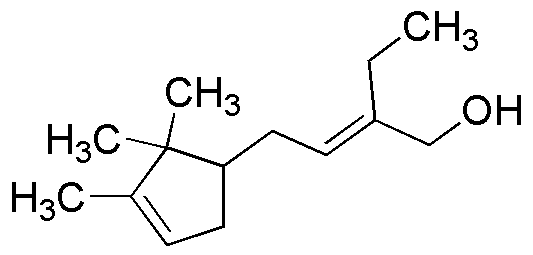2-Ethyl-4-(2,2,3-trimethylcyclopent-3-en-1-yl)-but-2-en-1-ol is widely utilized in research focused on:
- Fragrance Industry: This compound is used as a fragrance ingredient in perfumes and cosmetics, providing a unique scent profile that enhances product appeal.
- Flavoring Agents: It serves as a flavoring agent in food products, contributing to the taste and aroma, making it particularly valuable in the food and beverage sector.
- Pharmaceuticals: The compound is explored for its potential therapeutic properties, aiding in the development of new medications or supplements.
- Polymer Production: It can be utilized in the synthesis of specialty polymers, which are used in various applications including coatings and adhesives, offering enhanced performance characteristics.
- Research and Development: This chemical is a subject of study in organic chemistry research, helping scientists understand reaction mechanisms and develop new synthetic pathways.
General Information
Properties
Safety and Regulations
Applications
2-Ethyl-4-(2,2,3-trimethylcyclopent-3-en-1-yl)-but-2-en-1-ol is widely utilized in research focused on:
- Fragrance Industry: This compound is used as a fragrance ingredient in perfumes and cosmetics, providing a unique scent profile that enhances product appeal.
- Flavoring Agents: It serves as a flavoring agent in food products, contributing to the taste and aroma, making it particularly valuable in the food and beverage sector.
- Pharmaceuticals: The compound is explored for its potential therapeutic properties, aiding in the development of new medications or supplements.
- Polymer Production: It can be utilized in the synthesis of specialty polymers, which are used in various applications including coatings and adhesives, offering enhanced performance characteristics.
- Research and Development: This chemical is a subject of study in organic chemistry research, helping scientists understand reaction mechanisms and develop new synthetic pathways.
Documents
Safety Data Sheets (SDS)
The SDS provides comprehensive safety information on handling, storage, and disposal of the product.
Product Specification (PS)
The PS provides a comprehensive breakdown of the product’s properties, including chemical composition, physical state, purity, and storage requirements. It also details acceptable quality ranges and the product's intended applications.
Certificates of Analysis (COA)
Search for Certificates of Analysis (COA) by entering the products Lot Number. Lot and Batch Numbers can be found on a product’s label following the words ‘Lot’ or ‘Batch’.
*Catalog Number
*Lot Number
Certificates Of Origin (COO)
This COO confirms the country where the product was manufactured, and also details the materials and components used in it and whether it is derived from natural, synthetic, or other specific sources. This certificate may be required for customs, trade, and regulatory compliance.
*Catalog Number
*Lot Number
Safety Data Sheets (SDS)
The SDS provides comprehensive safety information on handling, storage, and disposal of the product.
DownloadProduct Specification (PS)
The PS provides a comprehensive breakdown of the product’s properties, including chemical composition, physical state, purity, and storage requirements. It also details acceptable quality ranges and the product's intended applications.
DownloadCertificates of Analysis (COA)
Search for Certificates of Analysis (COA) by entering the products Lot Number. Lot and Batch Numbers can be found on a product’s label following the words ‘Lot’ or ‘Batch’.
*Catalog Number
*Lot Number
Certificates Of Origin (COO)
This COO confirms the country where the product was manufactured, and also details the materials and components used in it and whether it is derived from natural, synthetic, or other specific sources. This certificate may be required for customs, trade, and regulatory compliance.


